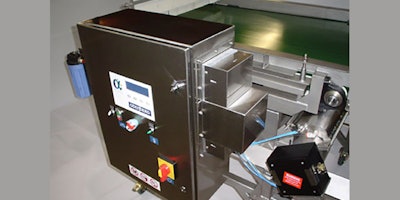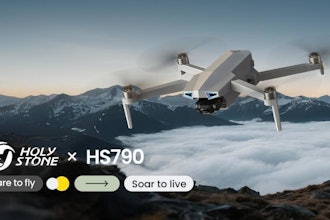
TECA Corporation
THERE ARE MANY places one can go to get an outline on the pros and cons of different methods for enclosure cooling. It seems one article at least per calendar year runs in the trade magazines. Although we will briefly
touch on them here, this is really an in-depth discussion on how to choose a
Peltier (thermoelectric) air conditioner, once you have committed to the technology.
Thermoelectric technology has seen advances and improvements in recent years.
An overview of the technology will outline benefits and drawbacks to the end user
followed by discussion of the newest innovations and factors to consider when
specifying a thermoelectric enclosure cooler.
Thermoelectric technology is easy to overlook due to
upfront cost or power requirements. Once educated
about and committed to the technology, however,
thermoelectric cooling can be the best choice for harsh
or hard-to-reach areas.
Thermoelectric Cooling : A Closer Look
Why Thermoelectric?
Protecting electronics equipment from both over-heating and from the ambient
environment is, hopefully, “a truth universally acknowledged”. It is best to have
an active cooling component in place as part of your system. Before going into
a detailed look at thermoelectric cooling, a few other technologies are quickly
outlined below.
Refrigerant air conditioners have their place- usually in large cooling applications
and easy-to-access areas. Heat exchangers, heat pipes and compressed air systems
can offer low cost cooling for smaller applications.
Thermoelectric cooling is the best choice for remote areas and harsh environments
such as wash-down areas, process automation systems, etc. Thermoelectric
technology might be chosen over the previous mentioned options where ease of
maintenance and long term operation costs are of concern.
Thermoelectric Cooling : A Closer Look
Electrical Insulation
Thermoelectric Technology in the Food & Beverage Industry
Industries across the board have a need for thermoelectric cooling in certain
applications. Within the food and beverage industry, thermoelectric air
conditioners are often used as part of a plant’s automation system. Cooling
sensitive instrumentation equipment, control computers, thin clients and monitors,
thermoelectric products excel in high ambient temperatures and can maintain
NEMA-4 and NEMA-4X enclosures in wash down and corrosive areas.
The Peltier Effect:
Thermoelectric cooling is created
via the Peltier effect: a solid-state
method of heat transfer through
dissimilar semiconductor materials.
Two dissimilar conductors replace
refrigerant in both liquid and vapor
form. A cold sink (evaporator
surface) becomes cold through
absorption of energy by the
electrons as they pass from one
semiconductor to another. A DC
power source pumps the electrons from one semiconductor to another and a
heat sink (condenser) discharges the accumulated heat energy from the system.
Thermoelectric air conditioners create a closed system. When installed properly
there is no exchange of ambient air into the enclosure.
Left: cooling process control electronics
enclosure in a beverage plant.
Right: cooling communications
equipment in a poultry plant.
Thermoelectric Cooling : A Closer Look
Thermoelectric air conditioners are low maintenance and have a long life
expectancy due to the solid-state nature of the technology. Free of refrigerants or
other chemicals, filters and compressors, the only moving parts are the fan.
Thermoelectric air conditioners are typically more expensive to purchase up front
compared to a refrigerant based cooler or a simple heat exchanger. However, the
reduced need for maintenance and replacement parts must be considered as part
of the value added to using the technology.
Thermoelectric air conditioners create
a closed system. There is no exchange
of ambient air into the enclosure.
Recent Changes to Thermoelectric Technology
In recent years, there have been innovations and improved products in the
thermoelectric market. Performance has increased and operation costs have
decreased. Efficiencies in heat/cool products and temperature control have
improved.
Energy Saving
New design features allow for energy
savings, such as including a passive
cooling mode when demand is lower.
This will draw significantly less current
than the active cooling mode used in
times of higher demand, thus reducing
operating costs without sacrificing
cooling.
Passive versus Active cooling modes
PASSIVE
300 BTU/hr thermoelectric air conditioner
ACTIVE
Thermoelectric Cooling : A Closer Look
Performance
In the past, thermoelectric air conditioners were limited in performance to about
2,000 BTU/hr. Now, increasingly efficient designs are allowing for air conditioners
with up to a half ton of cooling. This allows for thermoelectric cooling to be used
in larger enclosures such as high heat-generating control panels. This is partly
design innovation but also due to higher quality, more robust materials that are
now available to manufacturers, such as more efficient heat sinks and more reliable
thermoelectric modules.
Efficiencies
Modern thermoelectric modules heat more efficiently as well as cool
(via reversing the polarity of the module). This allows more thermoelectric products
to offer both cooling and reliable heating as the demand exists. By using the
thermoelectric modules for heating, efficiency is increased since electric heaters are
not needed. For either cooling-only needs or heat-and-cool applications, there is a
greater ability for tight temperature controls.
Thermoelectric air conditioners’ performance
range is larger than it used to be. Top: camera
housing cooling using a 200 BTU/hr thermo
electric unit. Right: high demand control
equipment enclosures being cooled with 6,ooo
BTU/hr thermoelectric units.
Choosing a System
Below is a guideline for specifying a thermoelectric air conditioner. Consider the
following factors:
1. How much cooling is needed
The total load is created by the heat your equipment is generating as well as
ambient conditions, delta-T, enclosure size, etc. How much cooling is required will
Thermoelectric Cooling : A Closer Look
be determined by many factors including the details of the enclosure and
surrounding environment. There are many sizing tools available online, free from
thermoelectric air conditioning manufacturers and enclosure manufacturers.
2. Allowable Enclosure Temperatures
Thermoelectric air conditioners are often used to cool equipment below ambient.
Most electronics are rated to 110F or so. Therefore, cooling an enclosure to 95F
might strike one as a warm rather than cool temperature, but is indeed more than
cool enough to keep electronics happy and running. Using an air conditioner
with more cooling capacity than what is needed can mean less efficiency. Also,
cooling significantly below ambient than what is needed can cause excessive
condensation.
In other words, design for allowable conditions both inside and outside the
enclosure. This includes basing maximum allowable internal temperature
around the known operating limits of your equipment rather than an arbitrary
temperature.
Know what the minimum enclosure temperature should be. If heat is needed in
winter months, an air conditioner with heat function can be considered.
3. Ambient Temperature Range
Along with understanding the environment, know what the ambient temperature
range is expected to be. In an outdoor application, this range might be much
larger than anticipated. Planning for the worst-case scenario is advisable.
4. The Importance of Fan Type
The IP (Ingress Protection) standard describes a uniform system for classifying the
degrees of protection provided by the enclosures of electrical equipment.
The first number refers to the level of protection against penetration of solid
objects into the enclosure. The second number refers to the level of protection
against penetration of liquids into the enclosure.
Air conditioners should - and often do - have both internal and external IP ratings.
The external rating is influenced most by the hot side (external to enclosure) fan
selection. Some environments call for fans that can withstand corrosives such
as salt spray or blowing sand. Mobile applications require shock and vibration
protection.
Thermoelectric Cooling : A Closer Look
NEMA Rating IP Rating
1 10
2 11
3 54
4 56
4X 66
6 67
12 52
13 54
Note: the comparison chart above is an
aproximation
NEMA & IP Ratings Comparison
Therefore, it is quite important to check with the manufacturer about what type of
fan is being used in an air conditioner and what other choices may be available.
There are industrial fans, fans sealed from water, fans protected from water AND
corrosives (such as salt, sand) and lastly, MIL-spec fans. Any of these will offer some
protection however the higher the IP rating of the enclosure, the more rugged a fan
will be required in the air conditioner to maintain enclosure integrity.
Thermoelectric air conditioners are meant to maintain the enclosure rating
and operate in that environment. Check the product literature or discuss your
environment with the air conditioner manufacturer to ensure the air conditioner
you choose will be adequate.
5. Input Voltage
Most thermoelectric air conditioners are available in a multitude of input voltages.
Systems with more cooling capacity are likelier to be 120 or 240 VAC although this
is not always so. Larger systems running off of 24 VDC will naturally have a higher
current draw as there are more thermoelectric modules used to obtain the cooling
capacity. If using VDC input, any power supply added to the enclosure interior will
add to the total heat load. This is an important consideration when determining the
cooling requirement.
Thermoelectric Cooling : A Closer Look
Mounting styles rendering
5. What to Notice Regarding Air Conditioner Specs
Currently, more conventional performance curves referencing the DIN 3168 L35L35
and L35L50 ratings are shown on air conditioner specifications. Traditional curves
referencing delta-T are still used. Ensure you are comparing air conditioners using
the same rating method. Example: performance curve per DIN 3168 (Left) and traditional
performance curve (Right)
6. Mounting style
A thermoelectric air conditioner will be designed by the manufacturer to be
mounted part way through the enclosure (“through mount”), external to the
enclosure (“flush mount”) or inside the enclosure (“internal” or “recessed” mount).
Operation in any orientation is
possible. Typically, “through
mount” systems are the least
expensive and offer greater
cooling capacity. Although the
true driving factor when choosing
ought to be the design of the
enclosure and location of other
equipment. The air conditioner will
perform best where there is
adequate air flow. Choose the mounting
style which gives both the hot side and cold
side of the air conditioner at least
several inches of breathing room
whenever possible.
Summary
Thermoelectric cooling is best suited to applications where low maintenance is
required or to harsh outdoor environments. Improvements to the technology and
the designs provide more reasons to consider it. Utilize online information and
work closely with a manufacturer of thermoelectric enclosure coolers to choose
the best solution.






















